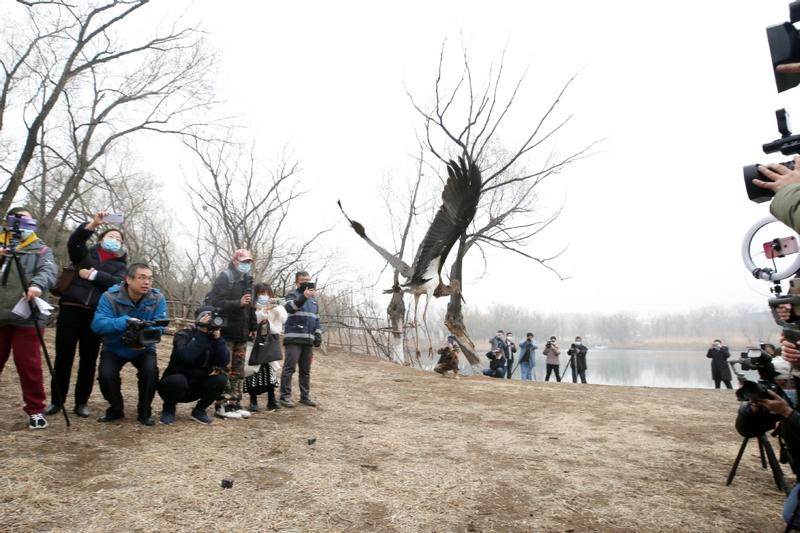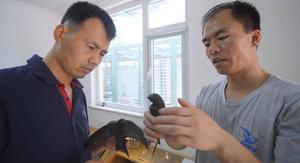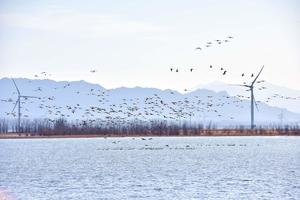Authorities strengthen efforts to protect species
 A black crane is photographed at the lake. (ZHANG YAN / FOR CHINA DAILY)
A black crane is photographed at the lake. (ZHANG YAN / FOR CHINA DAILY)
Residents of a city such as Beijing do not often see wild birds and animals, but this is not the case for Fang Chun.
For the past 15 years, he has been observing migratory birds in the capital's northwestern district of Yanqing, where their numbers are continuing to rise.
I am really excited when I catch sight of a new species, and hope to share my enthusiasm with more people in the near future
Fang Chun, wild bird monitor in Beijing
This year, Fang, 54, telescope in hand, began monitoring the birds at Wild Duck Lake National Wetland Park from the start of last month.
"The first flocks of migratory birds flying north arrived a few days after Spring Festival," he said.
In a log recording his observations, Fang wrote:"On Feb 12, the first whooper swan of the year appeared at the lake, while on Feb 18, five whooper swans, two smews (diving ducks) and nine mallard ducks came. Close to 1,000 common cranes also flew around the lake."
An estimated 100,000 migratory birds rest at the lake every year before moving further north for the summer, Fang said.
"In November and March, Wild Duck Lake becomes a 'swan lake' and there are magnificent views of the birds," he said.
Fang, who used to teach physical education, successfully turned his hobby of observing wild birds into a job by learning about avian species from books and photographs. He also sought help from experts.
He can now identify different species of migratory birds with just a single glance.
 Shi Yang (left) and a colleague treat injured birds at the Beijing Wildlife Rescue Center. (ZHANG YAN / FOR CHINA DAILY)
Shi Yang (left) and a colleague treat injured birds at the Beijing Wildlife Rescue Center. (ZHANG YAN / FOR CHINA DAILY)
Fang and three colleagues at the Wild Duck Lake monitoring station record the species and number of migratory birds. The team is also quick to rescue birds that are injured, treating them onsite during the migration season in spring and autumn.
Established in 2005, the Wild Duck Lake bird monitoring station was originally designed for watching a range of wildlife, but has since become an observation point for migratory birds.
There are 88 wildlife monitoring stations in Beijing. Ten of them are at national level, 33 at municipal level and 45 at district level. They basically cover all key areas of water, the birds' migration routes and their resting places.
Fang said that since February, he and his colleagues have observed more than 650,000 birds.
To minimize human disturbance to the birds, Fang said the wetland park closes from November to March every year. However, the team still needs to patrol the lake several times a day to check birds' health.
"If it is extremely cold, we bring some food for the birds to enable them to survive the tough conditions," he said.
 Whooper swans arrive at Wild Duck Lake in Yanqing district, northwestern Beijing. An estimated 100,000 migratory birds rest at the lake every year. (ZHANG YAN / FOR CHINA DAILY)
Whooper swans arrive at Wild Duck Lake in Yanqing district, northwestern Beijing. An estimated 100,000 migratory birds rest at the lake every year. (ZHANG YAN / FOR CHINA DAILY)
Public participation
As of this month, the Chinese capital was home to more than 500 species of terrestrial wildlife, up from 461 in 1994, according to the Beijing Gardening and Greening Bureau.
Shi Yang, senior engineer and director of the Beijing Wildlife Rescue Center's wild animal department, said that last year alone, the center treated 1,189 such animals from 140 species.
"The rare species we rescued and treated were mostly found by Beijing residents," Shi said.
He added that nearly every year from April onward, the Beijing swift, a small bird, frequently appears at the rescue center.
Shi usually gives these birds food six times a day every two hours. He strokes them, waiting for them to open their mouths, before popping the food in.
The birds, which have thin white lines on their breasts and four short claws, epitomize Beijing's avian diversity. The Beijing swift is a regular inhabitant of the city's palaces, temples and ancient towers.
In April, the swifts arrive in the city to breed, moving on to southern Africa in early August.
Shi said:"Beijing residents are familiar with the swift. In recent years, I have received a rising number of calls from people across the capital saying they have found injured swifts and want us to treat them.
"The number of volunteers eager to treat wildlife at the rescue center is rising and I sense that more people are learning about the lives of wild creatures in the city."
Beijing resident Wang Tian, 28, co-founder of an environmental protection studio, said he became committed to safeguarding different species after a group of high school friends encouraged him to take part in wildlife exploration activities.
"Since then, I have developed the habit of telling people about wild animals," he said.
 Shi Yang (left) and a colleague treat injured birds at the Beijing Wildlife Rescue Center. (ZHANG YAN / FOR CHINA DAILY)
Shi Yang (left) and a colleague treat injured birds at the Beijing Wildlife Rescue Center. (ZHANG YAN / FOR CHINA DAILY)
Legislation completed
With the number of wildlife species in Beijing rising due to the improved urban environment, local authorities have strengthened protection efforts.
In April last year, legislation was completed for the city's wild animal conservation regulation, which bans the consumption and trading of all terrestrial wildlife and certain aquatic species that are on the city's wildlife conservation list.
Anyone found artificially breeding wild animals faces a fine of 20,000 yuan to 100,000 yuan (US$3,074 to US$15,350), according to the regulation, which took effect on June 1 last year.
Dai Mingchao, deputy director of the Beijing Gardening and Greening Bureau, said to better implement the regulations, protection of wildlife species and habitats has been strengthened.
"Our main focus is on creating a good habitat for wild animals," he said, adding that the city now has 367,000 hectares of nature reserves and scenic spots, accounting for 22 percent of its land area.
In 2017, the Beijing municipal government began removing illegal structures and relocating manufacturing industry and some public services to neighboring counties in Hebei province.
The aim was to restore the city's traditional appearance and help it develop as a world-class and more-livable capital. The work will continue until 2030.
Dai said the relocation includes building city forests and small wetlands, along with storage facilities to provide food and water for wildlife.
"It's an important way for the capital to maintain wildlife biodiversity and promote the restoration of regional biodiversity," he said, adding that scientific research is also underway on the protection of wild animals in small populations.
This year, an additional 10,667 hectares of forest and 400 hectares of urban green spaces will be provided in Beijing, according to a plan released by the gardening and greening bureau last month.
Dai said that since 2018 at least one benjeshecken, also known as a "dead hedge", which is constructed from materials left over from pruning, clearing or forestry activities, has been planted on every 66.67 hectares of vacant land in Beijing.
Native plants and excess materials are then added to form an artificial barrier, which gradually provides food and shelter for small mammals and reptiles.
 Whooper swans arrive at Wild Duck Lake in Yanqing district, northwestern Beijing. An estimated 100,000 migratory birds rest at the lake every year. (ZHANG YAN / FOR CHINA DAILY)
Whooper swans arrive at Wild Duck Lake in Yanqing district, northwestern Beijing. An estimated 100,000 migratory birds rest at the lake every year. (ZHANG YAN / FOR CHINA DAILY)
Edge effect
According to local ecological conservation biologists, the mountains to the north and west of Beijing provide ideal resting places for migratory birds, while ancient imperial parks and buildings offer perfect habitats for other wild creatures.
But as the city has expanded, some farmland has been relinquished for construction. A rising number of people have also flocked to the capital, leading to traffic congestion and pollution.
Shi Yang, senior engineer at the Beijing Wildlife Rescue Center, said: "We worry about 'urban diseases' in the city resulting from the fragmentation of wild animal habitats. However, in ecology, there is the so-called edge effect-the possibility that wild creatures may embrace more biodiversity in two or more habitats."
He said that last year, the center treated and rescued 10 species of wild animals for the first time, including the relict gull and velvet scoter, which are rarely found in areas surrounding Beijing.
Sun Quanhui, a scientist with the World Animal Protection Association, said that in other cities such as New York and London, humans are also living in harmony with wild animals.
In October 2019, the nonprofit animal welfare organization launched a campaign calling for people to be kind to animals.
Sun advised government agencies in Beijing to step up coordination work and make more efforts to ensure people comply with local wildlife protection regulations. Information about enforcement of the regulations should be made public regularly, he said.
Fang, the bird watcher in Yanqing, is still thrilled when a new migratory bird species arrives at Wild Duck Lake for the first time.
Observing migratory birds is a lonely job, with the watchers spending most of the day walking around the lake.
"I am really excited when I catch sight of a new species, and hope to share my enthusiasm with more people in the near future," Fang said.



